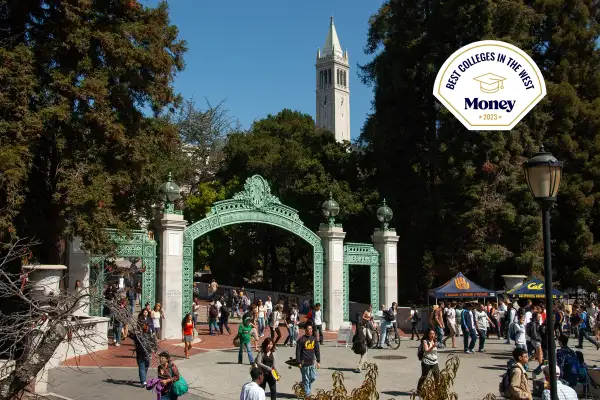Best Colleges in the West

While all seven colleges in the West that earned Money's highest 5-star rating this year are California universities, there's diversity within the bunch.
Northern California is represented by Bay Area rivals Stanford University and University of California, Berkeley, but Southern California also shines as home to an impressive number of colleges that our analysis finds are worth the money.
In the Los Angeles area, you have the smallest 5-star college in the West, Caltech, with just under 1,000 undergrads, and UCLA, one of the largest, with more than 32,000.
In all, four University of California system schools received Money's highest rating. That's remarkable but not necessarily surprising: UC schools routinely perform well in our annual analysis of the Best Colleges in America because they tend deliver on all three data categories in our methodology: affordability, quality and outcomes.
Ready for the West Coast college lifestyle? Below is a breakdown of the 5-star colleges in the region, in alphabetical order. See the full list of Best Colleges in the West here.
California Institute of Technology
- Location: Pasadena, California
- Estimated price with average grant: $32,300
- Graduation rate: 94%
- Early career earnings: $104,200
Even by the demanding standards of elite schools, Caltech is tough. Freshmen take their first-year courses pass/fail to ease into the school, but after that, professors are notoriously hard graders. With the challenging workload comes the chance to brush shoulders with some of the science world’s top thinkers: The school boasts 46 Nobel laureates and 42 MacArthur fellows among its alumni and faculty members. Full profile.
California Polytechnic State University, San Luis Obispo
- Location: San Luis Obispo, California
- Estimated price with average grant: $22,200
- Graduation rate: 83%
- Early career earnings: $85,800
Cal Poly is a skills-focused university with 65 majors, including one in wine and viticulture and several within its well-known engineering school. The campus, near the coast and about halfway between Los Angeles and San Francisco, covers more than 9,100 acres and uses canyons, ranches, beaches and even a farm to teach students hands-on lessons in agriculture, biology and forestry. More than 90% of Cal Poly graduates are working full time or in grad schools within a year, and they generally go on to earn strong early career salaries. Full profile.
Stanford University
- Location: Stanford, California
- Estimated price with average grant: $15,400
- Graduation rate: 94%
- Early career earnings: $107,000
Stanford is one of the hardest schools in the country to get into, accepting only 4% of applicants. Once there, the educational demands can be intense. Students often describe themselves as "ducks," because they try to appear serene while paddling desperately to keep going. But the results speak for themselves. Not only does Stanford have a 94% graduation rate, but its former students also founded Google, Yahoo, Cisco and many other tech companies. Full profile.
University of California, Berkeley
- Location: Berkeley, California
- Estimated price with average grant: $18,900
- Graduation rate: 93%
- Early career earnings: $88,000
As with many big universities, lower-level classes at Cal are large — one computer science course usually draws more than 1,000 students. But with scale also comes a mind-boggling array of choices for non-academic pursuits, including more than 60 sororities and fraternities, as well as hundreds of clubs. Sports are a big attraction on campus, and the Golden Bears' Division I sports teams tend to be very strong. Full profile.
University of California, Irvine
- Location: Irvine, California
- Estimated price with average grant: $12,500
- Graduation rate: 86%
- Early career earnings: $76,600
Founded in 1965, Irvine is one of the youngest campuses in the state's public university system, but it's already among the world's most respected research institutions. The university has a sweet location in the sunny suburbs of Orange County, just miles from famous California beaches and Disneyland, and about a one hour drive from downtown Los Angeles. Theme parks not your style? Surfing, snowboarding, skiing, sailing, cycling, desert camping, sunbathing and hiking are all on the table. Full profile.
University of California, Los Angeles
- Location: Los Angeles
- Estimated price with average grant: $14,400
- Graduation rate: 92%
- Early career earnings: $79,800
There's a lot of star power at UCLA. There are professors like computer science pioneer Leonard Kleinrock, who sent the first message over the internet. Scores of former students from the university's Theater, Film and Television school work in Hollywood. On the sports front, the Bruins have produced a galaxy of stars, including Arthur Ashe, Jackie Robinson and Kareem Abdul-Jabbar. That said, the university does a fine job of supporting ordinary students as well. Over a quarter of its students come from low-income families, and about 92% graduate in six years. Full profile.
University of California, San Diego
- Location: San Diego
- Estimated price with average grant: $16,800
- Graduation rate: 88%
- Early career earnings: $82,300
UCSD is renowned for its science programs and stellar faculty. Each year, hundreds of students flock to the university's gospel choir classes, thanks to the popularity of music professor Kenneth Anderson. Notable alumni include Mike Judge, creator of TV shows like King of the Hill, and Billy Beane, who put his UCSD economics coursework and statistical analysis training to use for the Oakland Athletics team — a feat immortalized in the book and movie Moneyball. The college's annual Sun God Festival is one of the most popular events of the year, attracting performers like Vince Staples, Snoop Dogg and Hayley Kiyoko. Full profile.
Notes: Prices for public universities reflect in-state tuition charges. Graduation rate measures degree completion within six years for both transfer students and first-time students. Early career earnings are the median earnings for both graduates and non-completers, 10 years after they first enrolled. Sources: U.S. Department of Education, Peterson’s, Money/Witlytic calculations.

